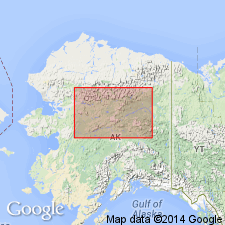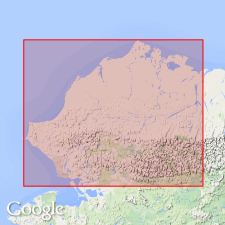
- Usage in publication:
-
- Rapids schist*
- Modifications:
-
- Named
- Dominant lithology:
-
- Schist
- AAPG geologic province:
-
- Alaska Northern region
Summary:
Occurs in narrow belt of highly metamorphosed or altered mica schist, traversed by Chandlar [Chandalar] River in region of rapids where unit forms low anticline with much quartz in bight of fold. Extends for several mi downstream nearly to West Fork. Appears to also occur on Middle Fork of Koyukuk at mouth of Bettles River. Does not seem to ascend high into mountains. Is supposed to lie next to basal granite. Seems to underlie Lake quartzite schist (new), but may prove to be lower member of that series. [no age given]
Source: GNU records (USGS DDS-6; Menlo GNULEX).

- Usage in publication:
-
- Rapids schist†
- Modifications:
-
- Abandoned
- Age modified
- AAPG geologic province:
-
- Alaska Northern region
Summary:
Rapids schist of Schrader (1900) in Chandalar district is not used in this report, because unit can not be defined lithologically, structurally, or paleontologically. Included in unnamed highly metamorphosed rocks of early Paleozoic or older age.
Source: GNU records (USGS DDS-6; Menlo GNULEX).
For more information, please contact Nancy Stamm, Geologic Names Committee Secretary.
Asterisk (*) indicates published by U.S. Geological Survey authors.
"No current usage" (†) implies that a name has been abandoned or has fallen into disuse. Former usage and, if known, replacement name given in parentheses ( ).
Slash (/) indicates name conflicts with nomenclatural guidelines (CSN, 1933; ACSN, 1961, 1970; NACSN, 1983, 2005, 2021). May be explained within brackets ([ ]).

